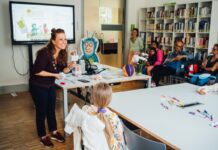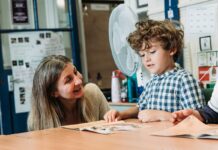We all get excited by our children’s steps in learning to talk. We realise communication holds the key to learning and socialising. Yet it is not typically on our radar of skills we think of boosting. Physical development through the fun of football, gym and swimming comes readily to mind, or the pleasure of music for auditory skills. But where does one go for something as fundamental as talking? Somewhere professional and fun?
What is Love Learning To talk?
Love Learning To Talk has just launched. An enriching communication skills programme for under-threes, this exciting new service for Kensington and Chelsea parents optimises how babies and toddlers learn to talk.
Designed by Dr Juliette Corrin, a specialist speech-language therapist, the programme makes learning to talk a joyful journey and boosts essential skills in preparation for preschool.
Flexibility is vital, with:
- quick boosts, e.g., four sessions
- longer-term support
- sessions at the LLTT playroom, at home or over Zoom
- on weekdays or weekends
Who benefits from Love Learning To Talk?
The programme suits babies and toddlers across the full spectrum of developmental abilities.
Juliette points out that Speech and Language Therapy is for all children, whether developing typically or experiencing developmental difficulty. Every child deserves an enriched opportunity to reach their full potential.
The first step is to profile development with either:
- a quick ‘check and see’ or
- a full diagnostic assessment
Then comes a tailored programme. Parents’ motivations vary; for example,
- to optimise communication with specialist therapy for developmental difficulty
- to boost late talking
- to enrich development beyond average
- to support learning English as an additional language
Is baby or toddler age too early?
As Juliette explains, one can compare learning to talk to a mille-feuille cake. It takes layer upon layer of foundation to get to the ‘creamy top’ of using words and early sentences in fluent conversation. For example, sharing joint attention in play, communicating purposefully through vocalisation and gesture, and taking turns in interactive game routines like ‘peek-a-boo’ are all foundation layers that successfully boost children’s progress from babyhood.
Supporting early communication is helpful for many good reasons:
- Birth to 3 years is the most rapid period of growth of neural brain networks
- Neural networks established in the first three years are the foundations for learning
- Toddlers have a limited domain of skill, so a boost makes a big difference
- Toddlers’ routines provide a rich opportunity for learning
What do parents and children experience?
The hallmark of Love Learning To Talk is personalised one-to-one support. Juliette emphasises the importance of building trusting relationships with clients, “Early communication skills grow in the heart of the family home. The more closely I relate to parents and babies/toddlers to understand how their world works, the more effective the programme can be”.

In individual sessions, parents enjoy tailored coaching in developmental techniques and witness their children gaining new skills in attention, listening, language comprehension, expression, and social interaction. In Juliette’s experience, this process is truly empowering for parents. Parents are the key to change and feel delighted to discover how simple new talking techniques boost progress. For example, replacing questions with comments gives the child a model of the language they need to take a turn in the conversation.
| Replace questions | With comments |
| What’s this? | Oh, look! A train. A red train. |
| Can you say tractor? | Tractor. It’s your t-r-a-c-t-o-r. |
| Do you need help? | Mummy help? Mummy help. |
| What are you building? | You’re building a castle. A big castle. |
What role do red light therapy and nutrition play?
Most families readily anticipate the play-based style of speech and language therapy typically offered to babies and toddlers, but red light therapy and nutrition might come as a surprise. This holistic approach is unique to Love Learning To Talk and reflects recent scientific advances in functional and bio-energetic medicine. Juliette is keen to describe the benefits these recent advances offer to the development of communication skills, combining three therapeutic pillars:
interactive routines + red light therapy + nutrition
 Red light therapy, known formally as photobiomodulation therapy (PBMT), energises tissue by gently applying red or near-infrared light to the body surface. With over 7000 clinical randomised control trials worldwide, PBM therapy is FDA-approved and fast gaining medical recognition as an entirely safe and quick method for boosting tissue function. Most importantly, this includes the brain. Love Learning To Talk offers babies and toddlers:
Red light therapy, known formally as photobiomodulation therapy (PBMT), energises tissue by gently applying red or near-infrared light to the body surface. With over 7000 clinical randomised control trials worldwide, PBM therapy is FDA-approved and fast gaining medical recognition as an entirely safe and quick method for boosting tissue function. Most importantly, this includes the brain. Love Learning To Talk offers babies and toddlers:
- state-of-the-art red light therapy during play
- a portable red light on trial for daily use at home
- gentle brain-boosting to support the learning of new communication skills
Nutrition research on the gut-brain axis has opened the door to our understanding that communication skills, as a core element of brain function, are influenced by nutrition. At the risk of over-simplifying the finely co-ordinated gut-brain relationship, Juliette puts it in a nutshell by saying, “What children eat influences how their brains function … within minutes … and over time”. At Love Learning To Talk, parents receive:
- information on well-researched, brain-nourishing nutrition plans
- practical home tips for preparing nourishing foods to support learning
- information on baby/toddler nutritional supplements for cognitive development
Are free consultations offered?
For a free video consultation, get in touch through the website enquiry form or text Juliette to chat about how you would like Love Learning To Talk to help your little one.
What is in the pipeline for 2023?
Parent workshops, small group sessions, and an outdoor class in Holland Park called ‘Larks in the Park’ are all on the cards! Lookout for details on the website and Instagram.
You might also like
Raising Bilingual Children in London: Choosing a Bilingual School





